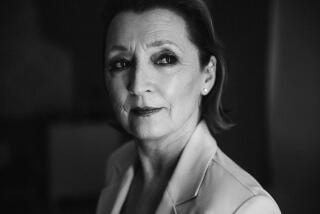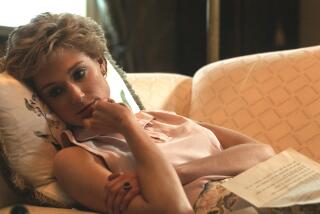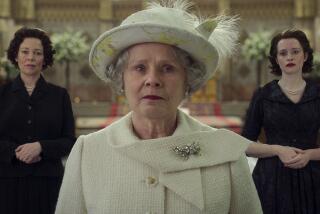Column: Playing royal is hard. That’s why it takes acting royalty to do it
- Share via
Some people, as the philosopher-poet Lorde has reminded us, will never be royal. Others, while not actually descended from families anointed by God, war and a heck of a lot of tea towels, are royal repeatedly. (Use our royal family tree, inspired by “The Crown,” to find out which actors have played which royals over the years.)
The problem with being Queen, at least according to “The Crown,” is that you are forced to be not one person but two: the actual human assigned the headgear and the figure the headgear demands. The challenge of playing the Queen, or any other royal lead, is that you must play not one part but two. Well, actually, three: the public persona, the private person and, perhaps most difficult, the transitional figure that exists between the two — sometimes all in the same scene.
For three seasons, Netflix’s “The Crown” has inspired viewers to research the royal family and British history. Wikipedia and Google data bear that out.
This tension, between the person and the title, is what makes royalty (and serial killers and mobsters) such a popular subject on film and television. We are endlessly fascinated with characters who juggle the mundane with the extraordinary. Bringing royalty to life involves making the still, often chilly mien of God-given power, authority and tradition as believable as the human foibles displayed behind the scenes. All while wearing lovely but highly uncomfortable clothing (including but not limited to a crown), which often limits physical action to a panoply of facial expressions, the gripping of tea cups or wine glasses and the occasional opportunity to sweep out of the room or down a hallway.
It’s a lot. So while pretty much every actor with a British accent has been a lord of this or countess of that, when it comes to the historical biggies — Henry VIII and all his poor wives; Lady Jane Grey; Mary Queen of Scots; Victoria; Elizabeths I and II; the Windsors in general — the talent pool grows smaller.
Helen Mirren, who has played both Elizabeths (in “The Queen” and the miniseries “Elizabeth I”) and Queen Charlotte (“The Madness of King George”), is now onto Russian royalty in “Catherine the Great.” (She also played Morgana in “Excalibur,” if we want to include King Arthur and company.) Cate Blanchett has played Elizabeth I twice — as well as Elizabeth II, if you count her voice work in an episode of “Family Guy.” And Judi Dench has played Elizabeth I (“Shakespeare in Love”) and Victoria twice (“Mrs. Brown,” “Victoria & Abdul”).
Not surprisingly, “The Crown” is full of repeat royals. Claire Foy, Elizabeth II in Seasons 1 and 2, played Anne Boleyn in “Wolf Hall”; Olivia Colman, who takes over from Foy in Season 3, just won an Oscar for her portrayal of Queen Anne in “The Favourite” and appeared as Queen Elizabeth, mother to Elizabeth II, in “Hyde Park on Hudson.”
Netflix’s ‘The Crown’ returns with Olivia Colman as its stunning new matriarch and a riveting, 1960s-set season that may be its strongest yet.
She isn’t the only Season 3 cast member to have played both mother and child — Helena Bonham Carter, who replaces Vanessa Kirby (and frankly steals the show) as Princess Margaret, played Queen Elizabeth, Margaret’s mother, in “The King’s Speech,” as well as the titular role in “Lady Jane Grey,” Anne Boleyn in ITV’s “Henry VIII” and (shades of Helen Mirren) Morgan le Fey in the series “Merlin.”
Alex Jennings, who took on David, Duke of Windsor, in the first two seasons, played Prince Charles in “The Queen” as well as King George III in the miniseries “Liberty! The American Revolution” and King Leopold in the series “Victoria.” Derek Jacobi, who replaces him in Season 3, has played pretty much all of Shakespeare’s kings and princes but, surprisingly, has nary a Windsor on his IMDb page. He was friends with the real Princess Margaret for a time, though, and that should count for something.
Oh, and while Season 3’s Princess Anne may be Erin Doherty’s first on-screen royal role, it almost certainly won’t be her last — especially if Netflix and Peter Morgan accede to my demand that Doherty’s Anne, who galvanizes every scene she’s in, get her own separate spinoff series.
When playing a royal, certain things help — a posh accent, good posture, expressive eyes, the ability to convey meaning with your jaw muscles alone — but in the end it comes down to the basics. To play Queen, you have to be a damn good actor.
More to Read
The complete guide to home viewing
Get Screen Gab for everything about the TV shows and streaming movies everyone’s talking about.
You may occasionally receive promotional content from the Los Angeles Times.







